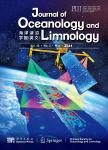Temporal dynamics of phytoplankton communities in a semi-enclosed mariculture pond and their responses to environmental factors
Temporal dynamics of phytoplankton communities in a semi-enclosed mariculture pond and their responses to environmental factors作者机构:Laboratory of Protozoology KLM Ocean University of China Department of Biological Sciences Inha University Department of Oceanography Inha University Zoology Department King Saud University Laboratory of Protozoology Key Laboratory of Ecology and Environmental Science in Guangdong Higher Education South China Normal University
出 版 物:《Chinese Journal of Oceanology and Limnology》 (中国海洋湖沼学报(英文版))
年 卷 期:2010年第28卷第2期
页 面:295-303页
核心收录:
基 金:Supported by the National Natural Science Foundation of China (Nos. 40976075, 30700069),a post-doctoral fellowship awarded to XU Henglong by Inha University a grant from the Center of Excellence in Biodiversity Research, King Saud University and the 111 Project of China (No. B08049)
主 题:bioindicator phytoplankton environmental stress microbial ecology shrimp-fanning temporal variations
摘 要:Variations in physical-chemical factors, species composition, abundance and biomass of nano-and micro-phytoplankton assemblages, as well as their responses to environmental factors, were investigated over a complete cycle (6 months) in a semi-enclosed shrimp-farming pond near Qingdao, northern China. The aim was to establish the temporal patterns of phytoplankton communities and to evaluate protists as suitable bioindicators to water quality in mariculture systems. A total of 34 taxa with nine dominant species were identified, belonging to six taxonomic groups (dinoflagellates, diatoms, cryptophyceans, chlorophyceans, euglenophyceans and chrysophyceans). A single peak of protist abundance occurred in October, mainly due to chlorophyceans, diatoms and chrysophyceans. Two biomass peaks in July and October were primarily due to dinoflagellates and diatoms. Temporal patterns of the phytoplankton communities significantly correlated with the changes in nutrients, temperature and pH, especially phosphate, either alone or in combination with NO3-N and NH3-N. Species diversity, evenness and richness indices were clearly correlated with water temperature and/or salinity, whereas the biomass/abundance ratio showed a significant correlation with NO3-N. The results suggest that phytoplankton are potentially useful bioindicators to water quality in semi-enclosed mariculture systems.



